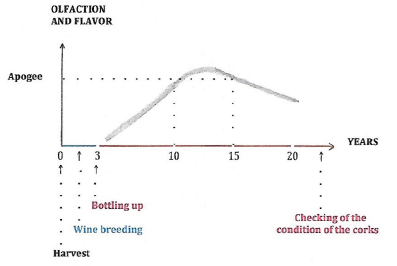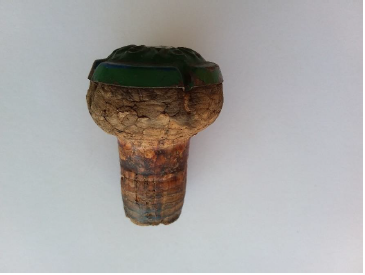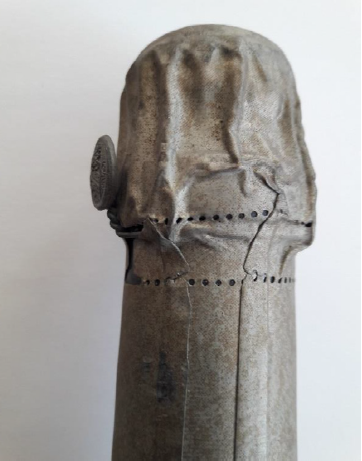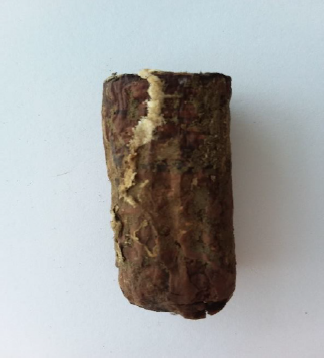- Submissions

Full Text
Academic Journal of Engineering Studies
The Aging of the Corks of Vintage Wines
Dassonville PF*
Freelance researcher, Author of The Invention of Time & Space (Springer 2017), France
*Corresponding author: Dassonville PF, Freelance researcher, Author of The Invention of Time & Space (Springer 2017), France
Submission: May 19, 2021 Published: June 04, 2021
.jpg)
ISSN:2694-4421 Volume2 Issue2
Abstract
Given that cork caps age, they should be checked after about 25 years. The examination of some bottle corks illustrates what threatens poorly preserved vintage wines. This study confirms that time is not the cause of aging, and it shows that analyzing negative events can generate knowledge.
Keywords: Biological aging; Time; Wine
Introduction
The need to check the condition of the cork caps has been shortly mentioned in an article titled « Does Time Improve the Quality of the Wine? [1]. Since then, I have had the opportunity to save from destruction a few empty bottles of vintage wines. As some still had their cork, an elementary investigation could be attempted. The photos of the corks allow examining their degradation and comparing the degradation between various wines. The analyses lead to explain the causes of biological aging of wine bottle corks, and why time is not involved. It can be considered an additional research about wine preservation.
The vintage wine aging
On the graph (Figure 1) we begin with the harvest at time zero. The year of harvest is indicated on the bottle and often on the cork. The wine breeding lasts between 1 and 3 years; it includes the maceration of the grapes between 2 and 3 weeks, and the vinification in oak barrels, until the cellar master (in French: maître de chai) decides, after regular testings, that it’s the right time for bottling. The wine ages once it’s bottled; not before. In other words, the wine does not age until it is bottled. In this particular case, aging means that the wine is going to open out. We are talking about biological aging instead of chronological aging [1]. The apogee of the balance of the olfaction and the flavor happens between about 10 and 15 years following the harvest: the wine has temporarily reached its highest level of quality, which means an optimal balance between flavor and olfaction, while keeping its typicality. Periodic wine tasting is the opportunity to carefully examine the condition of the corks; at least after 25 years, a cheking is required, because cork is, in a way, a living matter whose lifespan is limited. The bottle cap may need to be replaced [2].
Figure 1: Balance of the olfaction and the flavor of a vintage wine relative to an average timeline.

Origin of the use of the cork
The cork was used to stopper the amphorae from the 5th century BCE to 4th century CE, when amphorae were replaced by animal skin [3]. Early 18th century CE, it was discovered that wine in closed glass bottle was improving its quality [3]. The cork is the most suitable material for closing bottles because it is elastic, neutral, rot-proof, compressive and adhesive [3]. In addition, the cork allows infinitesimal but very complex exchanges between the wine and the outside atmosphere, hence the importance of the cellar’s role. The diameter of the cork is 24mm for still wines (in French: vins tranquilles) and 31mm for sparkling wines (in French: vins effervescents) [3] (Figure 2).
Figure 2: Closure device of champagne bottles.

The degradation of corks
The bottles that have been inspected, were stored lying down in the basement of a building on the Côte d’Azur, where they have undergone significant variations of temperature and humidity. The wines were obviously not drunk because the corks do not bear any corkscrew mark. The corks of still wines were inside the bottles and dried out enough to allow them to be taken out from the bottles easily. The bottle cap is the interface between the liquid and the outside of the bottle. The wine as well as the outside atmosphere cause a more or less lose of elasticity, compressively, grip, and an unavoidable retraction of the cork, which leads to the deterioration of the watertightness. Then the dioxide carbon and alcohol escape as well as a part of the liquid, the other part escape from the bottle by evaporation. However, the original quality of the corks is unknown, these degradation phenomena have undoubtedly been boosted by poor storage conditions.
Aging comparison
Even under appropriate wine storage conditions, the diameter of the cork cap is gradually decreasing. But as soon as the conditions are unsuitable the decreasing is accelerated. This basic comparison is done from a series of cork caps of various wines. It leads to notice that corks did not age in the same way, however they were stored in the same condition. There are several possible explanations, among which the heterogeneity of the quality of the cork, the biological state and the chemical composition of the wine, part of which turns into acetic acid, and the surrounding atmosphere of the storage room.
Champagne
None-vintage champagnes are elaborated with a blend of grape varieties from different years, in order to give the wine a constant character from one year to another. The legal aging in bottle is one year. Vintage champagnes are elaborated from a wine of high quality to which are added other wine varieties in limited quantities. The legal aging after bottling is three years at least.
Henry de peyrat
This bottle was open in 2021, over one year after the bottling. The diameter of the cork is 24mm instead of 31mm; therefore, the wine blend could not be kept more than one or two more years.
Heidsieck Monopole, 2010 vintage Champagne
This champagne was tasted in 2021, about the end of its apogee: slightly amber yellow color, very fine bubbles, wonderful taste. However, according to the condition of the plug, a diameter of 19/20mm instead of 31mm, it’s the right time to drink it (Figure 3).
Cuvée St Vincent R and L Legras et Chouilly vintage Champagne
Figure 3: A vintage to drink now.

The diameter of the cork is 15mm instead of 31mm (Figure 4). The elasticity and the compressivity of the cork are totally lost. The metal plate is still in place, but the cage and the bottle cap have disappeared.
Figure 4: Stamped 1970 on the cork cap.

Blason de France, Perrier-Jouet vintage Champagne (Figure 5)
The bottle is empty; however, it still has its muselet and its bottle cap with the seal of Blason de France.
Figure 5: The seal Blason de France on the left.

Dom Pérignon, Moët et Chandon vintage Champagne
The bottle has lost its muselet and most of its bottle cap. The cork, partly stuck, is still in place; but the bottle is empty (Figure 6).
Figure 6: The typical bottle neck of Dom Pérignon.

Beaujolais
Moulin-à-Vent, Louis Latour, 1961 vintage red wine. The cork is twisted, and its diameter is between 13 and 16mm instead of 24mm (Figure 7).
Figure 7: Stamped Beaujolais Beaune.

Burgundy
Santenay, Domaine de L’Abbaye, 1972 vintage red wine. The diameter is reduced from 24mm to 12/15mm (Figure 8). Corton- Charlemagne, Ancien Domaine des Comtes de Grancey, Louis Latour, 1959 vintage white wine. The diameter is between 12 and 15mm instead of 24mm at the origin (Figure 9).
Figure 8: White mold has grown on the cork once in the bottle.

Figure 9: This cork has many crevices.

Chambertin, Cuvée Héritiers Latour vintage red wine
Diameter of the fragment: 11/14mm instead of 24mm (Figure 10).
Figure 10: This fragment is crumbling.

Richebourg, Charles Noellat vintage red wine
Diameter: 12/13mm instead of 24 (Figure 11).
Figure 11: This cork has a charred appearance.

Conclusion
Cellar masters, wine waiters, oenologists and collectors, know how demanding wine preservation is. They know that bottle corks age by gradually losing their original physical qualities. The natural weakness of the corks requires a regular control of their condition, especially since an inappropriate atmosphere seems to accelerate their degradation, and consequently that of the wine: the oversight is an obvious concerned. The astonishing diversity of the above results illustrated by some photos, proves that the aging of the wine bottle corks is not caused by time: in fact, it comes to a biologic aging of the material, which is often aggravated by improper storage conditions.
References
- (2019) Does time improve the quality of the wine? (in EC NEUROLOGY, Published by ECRONICON).
- (1996) Le Guide Hachette des Vins. Hachette, France.
- (1988) La Vigne et le Vin (La Manufacture & La Cité des Sciences et de l’Industrie), Paris, France.
© 2021 Dassonville PF. This is an open access article distributed under the terms of the Creative Commons Attribution License , which permits unrestricted use, distribution, and build upon your work non-commercially.
 a Creative Commons Attribution 4.0 International License. Based on a work at www.crimsonpublishers.com.
Best viewed in
a Creative Commons Attribution 4.0 International License. Based on a work at www.crimsonpublishers.com.
Best viewed in 







.jpg)






























 Editorial Board Registrations
Editorial Board Registrations Submit your Article
Submit your Article Refer a Friend
Refer a Friend Advertise With Us
Advertise With Us
.jpg)






.jpg)














.bmp)
.jpg)
.png)
.jpg)










.jpg)






.png)

.png)



.png)






